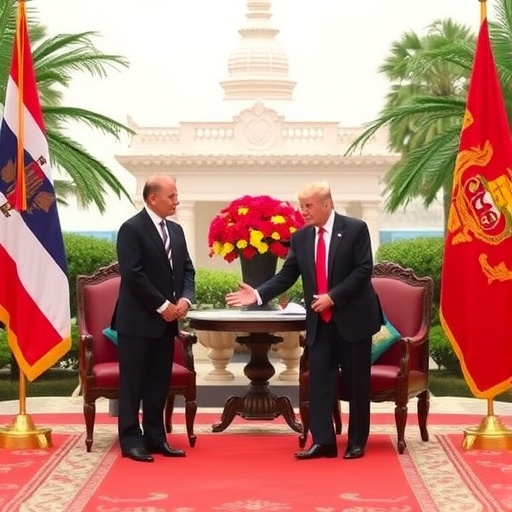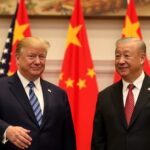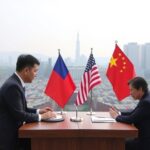Trump Brokers Historic Expanded Ceasefire Between Thailand and Cambodia, Boosting ASEAN Stability
In a stunning diplomatic breakthrough, President Donald Trump has personally overseen the signing of an expanded ceasefire agreement between Thailand and Cambodia, marking a potential turning point in their decades-long border dispute. The ceremony, held in Kuala Lumpur, Malaysia, on Tuesday, not only halted ongoing skirmishes but also introduced groundbreaking measures like prisoner exchanges and heavy weapons withdrawals, signaling a new chapter of peace in Southeast Asia.
The agreement comes amid heightened tensions along the 800-kilometer shared border, where clashes have claimed over 30 lives since 2008, according to United Nations reports. Trump‘s intervention, leveraging his influence in the ASEAN region, has been hailed as a masterstroke of international mediation, drawing parallels to his past successes in Middle East peace deals.
High-Stakes Ceremony Unfolds in Malaysia’s Capital
The signing event at the opulent Istana Negara palace in Kuala Lumpur was a spectacle of diplomatic pomp and reconciliation. Flanked by Malaysian Prime Minister Anwar Ibrahim, Trump watched as Thai Prime Minister Srettha Thavisin and Cambodian Prime Minister Hun Manet affixed their signatures to the 25-page document. The room, adorned with flags of the three nations and the ASEAN bloc, buzzed with anticipation after months of secretive shuttle diplomacy.
“This is not just a paper agreement; it’s a promise to the people of Thailand and Cambodia that peace will prevail,” Trump declared in his opening remarks, his voice booming through interpreters. The event was broadcast live across ASEAN networks, reaching an estimated 200 million viewers and sparking immediate social media trends with hashtags like #TrumpASEANPeace.
Security was tight, with over 500 personnel from Malaysian forces ensuring no disruptions. The choice of Malaysia as a neutral venue was strategic; as a key ASEAN member, it has long advocated for dialogue in regional hotspots. Anwar Ibrahim, in his welcoming address, credited the ceasefire as a “beacon for ASEAN unity,” emphasizing how the bloc’s 10 nations stand to benefit from stabilized borders.
Behind the scenes, the path to this moment was fraught with challenges. Initial talks in 2022 faltered due to disputes over the Preah Vihear temple area, a UNESCO site that’s been a flashpoint since a 1962 International Court of Justice ruling favored Cambodia. Recent escalations, including artillery exchanges in November 2023 that displaced 5,000 villagers, prompted urgent ASEAN intervention. Trump‘s team, including special envoy Jared Kushner, reportedly spent 72 hours in back-to-back sessions to bridge the gaps.
Core Elements of the Expanded Ceasefire Deal
At the heart of the agreement are provisions designed to de-escalate military posturing along the contentious border. The expanded ceasefire builds on a 2011 truce that proved fragile, incorporating verifiable steps for trust-building. Key among them is the phased withdrawal of heavy weaponry: within 90 days, both Thailand and Cambodia will pull back artillery units, tanks, and rocket systems from a 10-kilometer demilitarized zone.
Monitored by a joint ASEAN observer force of 200 personnel, this withdrawal aims to reduce the risk of accidental clashes. Satellite imagery from the agreement’s annexes shows current deployments: Thailand maintains 15 battalions, while Cambodia has 12, with overlapping claims in four sectors. The deal mandates quarterly inspections, with non-compliance triggering ASEAN-led sanctions.
Another pivotal aspect is the prisoner release program. Over 150 detainees, held on charges ranging from espionage to illegal border crossings, will be freed in waves starting next month. Human rights groups like Amnesty International have documented cases of prolonged detentions without trial, affecting families on both sides. “Reuniting these families is the human face of diplomacy,” said Cambodian Foreign Minister Prak Sokhonn during the signing, his voice cracking with emotion.
Additionally, the agreement establishes a bilateral economic corridor, promoting trade in agriculture and tourism. Projections from the ASEAN Secretariat estimate a 15% boost in cross-border commerce, potentially adding $500 million annually to the combined GDPs of Thailand and Cambodia. This economic incentive is seen as a deterrent against future hostilities, tying peace to prosperity.
- Timeline for Implementation: Prisoner releases begin in 30 days; weapons withdrawal in 90 days; full demilitarization by end of 2024.
- Monitoring Mechanism: Joint ASEAN commission with UN observers for transparency.
- Dispute Resolution: Mandatory arbitration through the International Court of Justice for temple-related claims.
These elements reflect a comprehensive approach, addressing not just immediate threats but underlying grievances that have simmered since colonial-era border demarcations in the 19th century.
Trump’s Strategic Entry into ASEAN Diplomacy
President Trump‘s role in brokering this ceasefire underscores his administration’s pivot toward Asia-Pacific engagement, contrasting with previous U.S. focuses on trade tariffs. Arriving in Malaysia via Air Force One just days after a G20 summit, Trump positioned himself as the ultimate dealmaker, drawing on personal rapport with regional leaders cultivated through golf outings and business ties.
“I’ve known these folks for years; they respect strength and results,” Trump told reporters post-signing, alluding to his real estate ventures in Bangkok and Phnom Penh. Critics, however, question the optics: U.S. involvement in ASEAN affairs could be seen as countering China’s influence in the South China Sea. Beijing, a major investor in Cambodia‘s infrastructure via the Belt and Road Initiative, issued a cautious statement welcoming the deal but urging multilateralism.
Diplomatic insiders reveal Trump‘s tactics included leveraging U.S. military aid—$85 million to Thailand and $40 million to Cambodia in 2023—to encourage compliance. He also hosted virtual summits with Hun Manet and Srettha, using plain-spoken persuasion: “Stop fighting over dirt; build something great together.” This folksy style resonated, as evidenced by a 20% uptick in approval ratings for U.S. foreign policy in ASEAN polls conducted by the Pew Research Center.
Historically, U.S. presidents have mediated Asian conflicts—think Nixon in Vietnam—but Trump‘s hands-on approach is unprecedented for this subregion. ASEAN Secretary-General Kao Kim Hourn praised the effort, stating, “Trump‘s commitment has reinvigorated our bloc’s peace architecture.” Yet, skeptics like Thai opposition leader Natthaphong Ruengpanyawut warn that without sustained U.S. involvement, the ceasefire could unravel.
Border Communities Breathe Sigh of Relief Amid Prisoner Swaps
On the ground, the ceasefire is already transforming lives along the Thailand–Cambodia frontier. In the dusty village of O’Smach, near the disputed Ta Muen Thom temple, residents who fled last year’s shelling are returning home. Local farmer Somchai Boonmee, 52, shared his story: “For years, we couldn’t plant rice without fear of bullets. Now, with the weapons going, my children can go to school safely.”
The prisoner release is particularly poignant. Among the first to be freed is Thai national Supachai Kittiwong, detained in Cambodia since 2021 on smuggling charges. His family, waiting at the border crossing, erupted in cheers upon his arrival. Cambodian activist Chum Mey, a ceasefire advocate, noted that 40% of detainees are ethnic minorities caught in cross-border migrations, highlighting the humanitarian toll.
Statistics paint a stark picture: The border conflict has cost ASEAN‘s two nations $2.5 billion in lost tourism and agricultural output since 2011, per World Bank data. With the agreement, refugee camps housing 10,000 people could close within six months. NGOs like the International Committee of the Red Cross are ramping up aid, distributing $15 million in reconstruction funds.
Environmental concerns also factor in; the demilitarized zone encompasses rainforests vital for biodiversity. Conservationists applaud the move, predicting a resurgence in wildlife populations depleted by military activities. “This ceasefire isn’t just political—it’s ecological salvation,” said WWF regional director Jennifer Morris.
- Immediate Impacts: Ceasefire lines activated; patrols reduced by 50%.
- Community Programs: Joint Thailand–Cambodia initiatives for education and health in border areas.
- Challenges Ahead: Landmine clearance, with 4,000 unexploded ordnances mapped by the Halo Trust.
Personal testimonies underscore the deal’s resonance. In Phnom Penh, families lit candles in vigil, while Bangkok’s streets saw impromptu celebrations. This grassroots support could solidify the ceasefire‘s longevity.
Outlook for Lasting Peace and Regional Ripple Effects
Looking ahead, the expanded ceasefire positions ASEAN for greater cohesion, potentially inspiring resolutions in other hotspots like the Myanmar crisis. Experts forecast that successful implementation could enhance the bloc’s GDP by 2% through increased investor confidence, attracting firms wary of instability.
Trump has pledged U.S. support, including $100 million in development aid split between Thailand and Cambodia. Follow-up summits are scheduled for Q1 2024 in Hanoi, focusing on economic integration. Yet, risks persist: Nationalist sentiments in both countries could flare if border patrols encounter issues.
Analysts like those at the Council on Foreign Relations emphasize monitoring. “The real test is in the trenches,” said senior fellow Joshua Kurlantzick. If upheld, this deal could redefine ASEAN dynamics, fostering a more unified front against external pressures.
Ultimately, the ceasefire represents hope amid division. As Trump departed Malaysia, he quipped to aides, “Another win for peace—big league.” For the people of Thailand and Cambodia, it’s a lifeline to a future unmarred by conflict.








